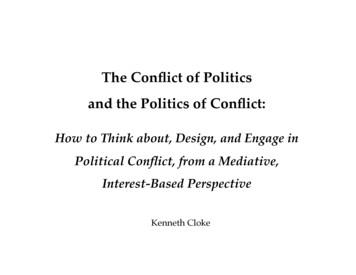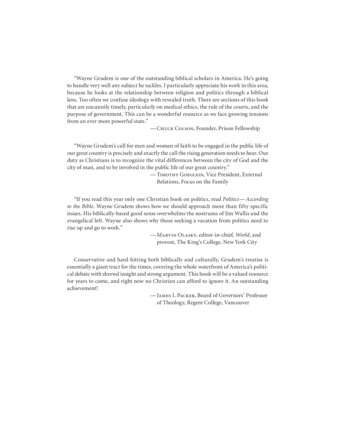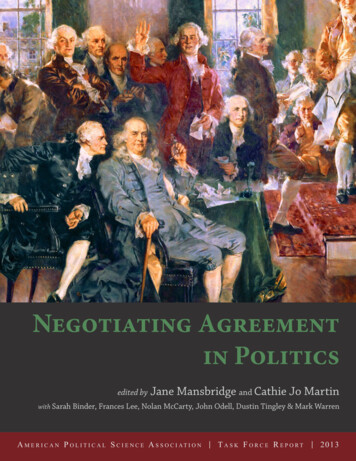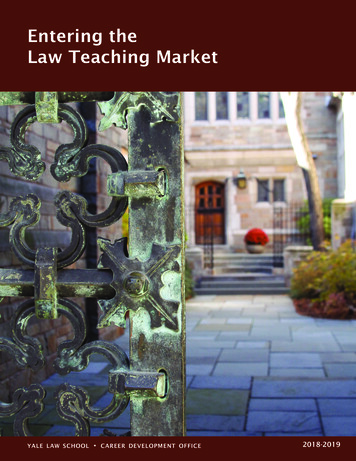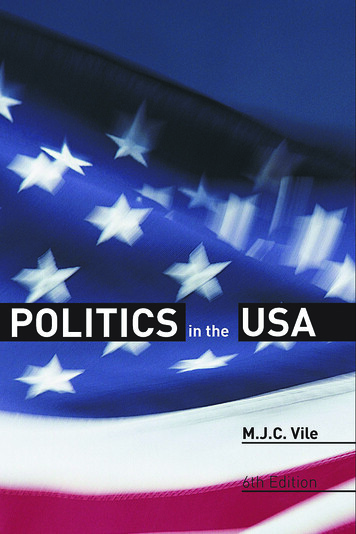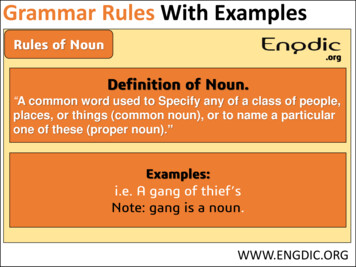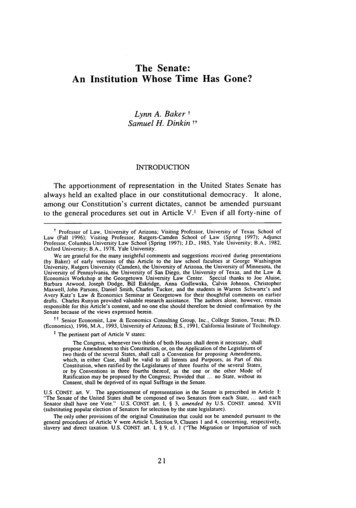
Transcription
The Senate:An Institution Whose Time Has Gone?Lynn A. Baker fSamuel H. Dinkin f4INTRODUCTIONThe apportionment of representation in the United States Senate hasalways held an exalted place in our constitutional democracy. It alone,among our Constitution's current dictates, cannot be amended pursuantto the general procedures set out in Article V. 1 Even if all forty-nine ofProfessor of Law, University of Arizona; Visiting Professor, University of Texas School ofLaw (Fall 1996); Visiting Professor, Rutgers-Camden School of Law (Spring 1997); AdjunctProfessor, Columbia University Law School (Spring 1997); J.D., 1985, Yale University; B.A., 1982,Oxford University; B.A., 1978, Yale University.We are grateful for the many insightful comments and suggestions received during presentations(by Baker) of early versions of this Article to the law school faculties at George WashingtonUniversity, Rutgers University (Camden), the University of Arizona, the University of Minnesota, theUniversity of Pennsylvania, the University of San Diego, the University of Texas, and the Law &Economics Workshop at the Georgetown University Law Center. Special thanks to Joe Aluise,Barbara Atwood, Joseph Dodge, Bill Eskridge, Anna Godlewska, Calvin Johnson, ChristopherMaxwell, John Parsons, Daniel Smith, Charles Tucker, and the students in Warren Schwartz's andAvery Katz's Law & Economics Seminar at Georgetown for their thoughtful comments on earlierdrafts. Charles Runyan provided valuable research assistance. The authors alone, however, remainresponsible for this Article's content, and no one else should therefore be denied confirmation by theSenate because of the views expressed herein.f Senior Economist, Law & Economics Consulting Group, Inc., College Station, Texas; Ph.D.(Economics), 1996, M.A., 1993, University of Arizona; B.S., 1991, California Institute of Technology.The pertinent part of Article V states:The Congress, whenever two thirds of both Houses shall deem it necessary, shallpropose Amendments to this Constitution, or, on the Application of the Legislatures oftwo thirds of the several States, shall call a Convention for proposing Amendments,which, in either Case, shall be valid to all Intents and Purposes, as Part of thisConstitution, when ratified by the Legislatures of three fourths of the several States,or by Conventions in three fourths thereof, as the one or the other Mode ofRatification may be proposed by the Congress; Provided that .no State, without itsConsent, shall be deprived of its equal Suffrage in the Senate.U.S. CONST. art. V. The apportionment of representation in the Senate is prescribed in Article I:"The Senate of the United States shall be composed of two Senators from each State. . and eachSenator shall have one Vote." U.S. CONST. art. I, § 3, amended by U.S. CONST. amend. XVII(substituting popular election of Senators for selection by the state legislature).The only other provisions of the original Constitution that could not be amended pursuant to thegeneral procedures of Article V were Article I, Section 9, Clauses I and 4, concerning, respectively,slavery and direct taxation. U.S. CONST. art. I, § 9, cl.I ("The Migration or Importation of such
Journal of Law & Politics[Vol. XIII:21the other states were to agree, "no State, without its Consent, shall be'2deprived of its equal Suffrage in the Senate."In recent times, however, the allocation of representation in theSenate also has required some awkward explaining. Following theSupreme Court's 1962 decision in Baker v. Carr,3 states that havesought to mimic Congress in their scheme of representation haverepeatedly been told that "such a plan is impermissible for the Statesunder the Equal Protection Clause ' 4 because it violates "[t]he right of acitizen to equal representation and to have his vote weighted equallywith those of all other citizens" in both houses of a bicamerallegislature. 5 The Court simultaneously has excused the federallegislature's denial of this same right by invoking the "compromiseand concession indispensable to the establishment of our federal7republic" 6 and the independent sovereignty of the states.But historical explanation is not contemporary justification. 8 Twohundred years, twenty-seven amendments, and thousands of SupremeCourt decisions after the ratification of our Constitution, the role of theSenate in our structure of government deserves another look. Thequestion is not whether the Framers' allocation of representation "isirrational or involves something other than a 'republican form ofgovernment,"' 9 but whether the legal changes, political lessons, andintellectual progress of the last 200 years might now enable us-indeed,require us-to do better.Persons as any of the States now existing shall think proper to admit, shall not be prohibited by theCongress prior to the Year one thousand eight hundred and eight .");U.S. CONST. art. I,§ 9, ci. 4("No Capitation, or other direct, Tax shall be laid, unless in Proportion to the Census or Enumerationherein before directed to be taken."). With regard to these provisions, Article V stipulated that "noAmendment which may be made prior to the Year One thousand eight hundred and eight shall in anyManner affect" them. U.S. CONST. art. V.2 U.S. CONST. art. V.3 369 U.S. 186 (1962) (holding a challenge to the apportionment of a state legislature to pose ajusticiable question).4 Reynolds v. Sims, 377 U.S. 533, 575 (1964); see also Maryland Comm. for Fair Representationv. Tawes, 377 U.S. 656 (1964).5 Reynolds, 377 U.S. at 576; Tawes, 377 U.S. at 674; see also Wesberry v. Sanders, 376 U.S. 1, 8(1964) ("one man's vote .is to be worth as much as another's"); Lucas v. Forty-Fourth Colo. Gen.Assembly, 377 U.S. 713, 736 (1964), affd in part and vacated in part, 379 U.S. 693 (1965) ("Anindividual's constitutionally protected right to cast an equally weighted vote cannot be denied even bya vote of a majority of a State's electorate.").6 Reynolds, 377 U.S. at 574; see also Wesberry, 376 U.S. at 9-14.7 Reynolds, 377 U.S. at 575.8 Indeed, somewhat ironically, the Court in Reynolds also stated that "neither history alone, noreconomic or other sorts of group interests, are permissible factors in attempting to justify disparitiesfrom population-based representation." 377 U.S. at 579-80 (emphasis added).9 Id.at 575.
1997]The SenateIn this Article, we demonstrate that our nation would be better servedtoday by a federal legislature, whether unicameral or bicameral, whichafforded the states representation solely in proportion to their shares ofthe nation's population and which employed a supermajority decisionrule. We also show, however, that there is scant theoretical or realpossibility of adopting this scheme under the Constitution, even thougha supermajority of the American people is demonstrably disadvantagedby the existing arrangement. To the extent that the existing allocationof representation in the Senate systematically disadvantages residents ofthe large-population states, we are left to ponder why the five large statesamong the original thirteen agreed to this structure of congressionalrepresentation.Part I of this Article explains how the existing allocation ofrepresentation in the Senate provides small-population states adisproportionately great coalition-building power relative to their sharesof the nation's population, and how it injects a significant supermajoritarianism into the federal lawmaking process. This Part fills animportant gap in the political science literature by presenting both amodel for determining the power that each state theoretically has inCongress as a whole and the computer-calculated results of that model.In Part II, this Article demonstrates that the disproportionately greatcoalition-building power that the Senate affords small states, and thesupermajoritarianism it injects into the federal lawmaking processcombine to produce three problematic effects on the structure ofgovernment.First, the Senate systematically and unjustifiablyredistributes wealth from the large population states to the small ones.Second, it systematically and unjustifiably provides racial minorities avoice in the federal lawmaking process which is disproportionately smallrelative to their numbers. And finally, it systematically and unjustifiablyaffords large population states disproportionately little power, relative totheir shares of the nation's population, to block federal homogenizinglegislation that they consider disadvantageous.Part III proposes that representation in the Senate be allocated to thestates in proportion to their shares of the nation's population, and thatthe Senate thus constituted employ a supermajority decision rule. Itargues that this alternative structure of representation retains theadvantages of the Senate's current structure while eliminating itsdisadvantages. The implications of this proposal for the House are alsodiscussed. Part IV considers both the constitutional barriers and thepossible constitutionally-based routes to adopting the proposed changes,
Journalof Law & Politics[Vol. XIII:21and concludes that there is little theoretical or real possibility of reformunder the existing Constitution.Part V seeks to explain the origins of the predicament in which wenow find ourselves. It examines whether the consent that the fiveoriginal large states gave to the Constitution (and therefore to Article I'sallocation of congressional representation) can be explained within theconfines of interest group theory's rational actor model. The Articleconcludes by discussing one important practical implication of itsanalysis for current American lawmaking and its equally importantimplications for the new democracies continually emerging around theworld.I. THE STRUCTURE OF REPRESENTATION IN THE SENATEBy providing the states equal representation without regard topopulation,' 0 the Senate affords small-population states ("small" states)disproportionately great representation, and large-population states("large" states) disproportionately little representation, relative to theirshares of the nation's population. This in turn means that the smallstates have disproportionately great coalition-building power in theSenate relative to their shares of the population.One measure of a state's theoretical "coalition-building power" isthe likelihood that it will be the swing vote on any proposedlegislation." In the Senate, each state has the same 2-in-100 theoreticalchance to be the swing vote on a given piece of proposed legislation. 12In the language of modern game theory, the Shapley-Shubik powerindex of every state is equal in the Senate. 13 But this means that smaller10 U.S. CONST.art. 1, § 3, cl.1.11 The notion of the swing voter or "pivot" for the winning coalition is central to both theShapley-Shubik power index and the Banzhaf power index. See MARTIN SHUBIK, GAME THEORYIN THE SOCIAL SCIENCES: CONCEPTS AND SOLUTIONS 200-04 (1982). We assume throughout thateach state's representatives vote as a block. Relaxing this assumption simplifies the calculations wediscuss in this part, but does not change the results.12 Each Senator has the same one-in-lO0 theoretical chance to be the swing vote on anyproposed legislation. And each of the fifty states is represented by two Senators, each with one vote.See U.S. CONST. art. I, § 3, cl. 1.13 The Shapley-Shubik index considers all possible orders in which a vote can take place. Forany ordering of n players (voters) there will be a unique player who is in a position to provide thewinning coalition with just enough strength to win. That player is the pivot for the coalition. If all n!orderings are assumed equiprobable, then the Shapley-Shubik index is a measure of the probabilitythat any player is pivotal. If one assumes instead that every winning coalition is equiprobable, theBanzhaf Index can be used to measure the probability that any one player (voter) is pivotal. SeeSHUBIK, supra note 11, at 200-04. The analysis is not affected, however, by one's choice ofassumptions or the index used.
1997]The Senatestates have a disproportionately great likelihood, relative to their sharesof the nation's population, of being the swing vote on any proposedlegislation. In the House, in contrast, where each state's representationis substantially proportional to its population,14 the theoreticallikelihood that a small state is the swing vote on any proposedlegislation is roughly equal to its share of the population and thereforesmall.' 5 This means that smaller states are less likely than larger states toThere are 100 players (Senators) in the Senate. Thus, there are 100! possible orderings in whicha vote can take place. Because each player has the same number of votes (one) on a given piece ofproposed legislation, each player has the same likelihood of being the swing vote. And, since eachstate is represented by the same number of players (two Senators) each state has the same likelihoodof being the swing vote. Calculated precisely, each state has a 2-in- 100 chance to be the swing voteon any given piece of proposed legislation, and each state's Shapley-Shubik index is therefore .02.Although in this instance each state's (and each player's) Shapley-Shubik index is the same as itsvoting strength, that will not always be the case. Indeed, a major contribution of the Shapley-Shubikindex is to demonstrate the erroneousness of the common intuition that the a priori power distributioninherent in a given apportionment of voting strength is always a trivial function of the nominal votingstrengths. In particular, the Shapley-Shubik index shows that large weighted majority games (such asthe electoral college) give a disproportionate power advantage to the big players, and that somevoters may be incapable of affecting the outcome of any proposed legislation even though they havea vote. The former finding is presented in Irwin Mann & L.S. Shapley, The A Priori Voting Strengthof the Electoral College, in GAME THEORY AND RELATED APPROACHES TO SOCIAL BEHAVIOR 15164 (Martin Shubik ed., 1964) (demonstrating that states with 16 or more votes in the electoral collegehave a Shapley-Shubik index slightly greater than their number of votes, while states with 14 or fewervotes have a Shapley-Shubik index that is slightly smaller than their number of votes). The latterfinding is demonstrated by the following example:Consider a game with four players (or coalitions)-A, B, C, d-with votes of 2, 2, 2, and I,respectively. A simple majority of four votes is needed to carry a motion. In each of the 24 (4!)possible orderings of the four players, the pivot is CAdCBALynn A. Baker, Direct Democracy and Discrimination: A Public Choice Perspective, 67 CHI.-KENTL. REV. 707, 730 n.83 (1991). The Shapley-Shubik indices for A, B, C, and d are, respectively 8/24(.33), 8/24 (.33), 8/24 (.33), and 0/24 (0). Thus, although the player denoted d has 1/n of the totalvoting strength in this hypothetical body, it can be shown to have no power. That is, it can be shownmathematically to be incapable of affecting the outcome of any motion, no matter how it votes. Id.;see also SHUBIK, supra note I1, at 203-04. Similarly, in a game with three players with votes of 2, 2,and I, respectively, each of the players has a Shapley-Shubik index of 0.33 if a simple majority ofthree votes is required for passage. Thus, even though one player has a voting strength only one-halfas large as the others', his power to affect the outcome of any vote is identical to theirs.14 Because the Constitution provides that "each State shall have at Least one Representative" nomatter how small its population, the smallest states may be slightly overrepresented in the House eventhough representation in that body is "apportioned among the several States . according to theirrespective Numbers."U.S. CONST. art. 1, § 2, cl. 3, Thus, although California, for example,currently has nearly 66 times the population of Wyoming (29,760,021 versus 453,588), it has only 52times as many Representatives in the House (52 versus 1). See THE COUNCIL OF STATE GOV'TS, 30THE BOOK OF THE STATES 635-36 tbl.10.3 (1994-95 ed.) [hereinafter THE BOOK OF THE STATES].15 For two reasons, a small state's Shapley-Shubik index will only approximate, rather than be
Journal of Law & Politics[Vol. XIII:21cast the deciding vote in the House. In sum, the Shapley-Shubik power6index of a small state is larger in the Senate than in the House.'Of course, neither the House nor the Senate alone may enactlegislation; the approval of at least a simple majority present in eachbody is required.' 7 Thus, one must determine each state's theoreticalcoalition-building power in the Congress as a whole. It is important toappreciate that one cannot simply add a state's power indices in theHouse and in the Senate, then divide by two. Naively adding thelikelihood that a particular state is the swing voter in the House oncelegislation has already passed the Senate and the likelihood that it is theswing voter in the Senate once legislation has already passed the House,giving equal weight to these two possibilities, will result in a uselessmeasure. One seeks instead to measure the frequency with which aparticular state will be the pivot or swing voter in Congress. A state isthe swing voter in Congress whenever its votes in Congress as a wholeenable legislation to pass that would not have passed without its votes.Table I presents the first computer calculations of each state'sShapley-Shubik power index for Congress.'" Comparing any large andsmall state, one can see that the disproportionately great power, relativeto its share of the nation's population, that the Senate affords a smallstate is only very slightly mitigated by the proportional representationthat the House provides.Consider, for example, the followingidentical to, its share of the nation's population. First, as explained in note 14, supra, the smalleststates' voting strength in the House slightly exceeds their actual share of the nation's population.Second, as explained in note 13, supra, large weighted majority voting games such as the House givea disproportionate power advantage to the big players. For a complete listing of the various states'current Shapley-Shubik power indices for the House, Senate, and Congress, and their number ofHouse Representatives, see Table 1, infra.16 See infra Table 1. Similarly, the voting strength of a small state is greater in the Senate than inthe House. See supra note 13.17 See U.S. CONST. art. 1, § 7, cl. 2. Sometimes, of course, more than a simple majority of one orboth chambers is required, as in the case of Senate filibusters, see infra note 28, in order to override aPresident's veto, see U.S. CONST. art. I, § 7, cl. 2, or where supermajorities are required by theConstitution. See infra notes 146-49.18 A formal mathematical statement of how these Shapley-Shubik values were calculatedappears in Appendix One, infra. Appendix Two, infra, contains the computer program used tocalculate the values presented in Table 1, infra.
The Senate19971TABLE IShapley-Shubik Power Indices for the StatesAfter 1990 ReapportionmentStateCANYTXFLPAILOHMINJNCGA; VAMA; INMO; WI;TN; WAMD; MNLA; ALKY; AZ; SC;CO; CT; OKOR; IA; MSKS; ARWV; UT;NE; NMME; NV;NH; HI; ID;RIMT; SD; DE;ND; VT; 3121110Index 25.022Index forSenate.02.02.02.02.02.02.02.02.02.02.02.02Index 2.0111.002.02.010
Journal of Law & Politics[Vol. XIII:21relationships between California and Rhode Island: 19population 2 29.7 to 1power in House 2'32.5 to 122power in Senate1 to 1power in Congress 23 7.4 to 1Counterintuitively, the ratio of California's and Rhode Island's power inCongress (7.4 to 1) turns out not to be the midpoint between the ratio oftheir power in the House and in the Senate (16.25 to 1), but much morenearly approximates the ratio of their power in the Senate (1 to 1) thanthe ratio of their power in the House (32.5 to 1).Of course, theoretical measures of coalition-building power such asthe Shapley-Shubik power index capture only part of the complexreality. The committee system, seniority, savvy, and charisma-to namejust a few variables-all affect a particular legislator's, and therefore aparticular state's, actual coalition-building power in the Senate.Happily, however, we need not attempt to quantify these myriad, oftenintangible, variables. For the apportionment of representation in theSenate also determines the likelihood that an especially powerfulSenator-by any measure of influence-represents a particular state.Thus, West Virginia, for example, has a 2-in-100 chance of havingone of its representatives chair all of the important Senate committees24and otherwise wield the influence that Senator Byrd historically has.19 Rhode Island was chosen because it receives two Representatives in the House. See THEBOOK OF THE STATES, supranote 14, at 635-36 tbl.10.3. States such as Wyoming that receive onlyone Representative may be overrepresented in the House because of the Constitution's dictate that"each State shall have at Least one Representative" no matter how small its share of the nation'spopulation. U.S. CONST. art. I, § 2, cl. 3.20 See THE BOOK OF THE STATES, supra note 14, at 635-36 tbl.10.3.21 See supra Table 1.22 See supra Table 1.23 See supra Table 1.24 In the 104th Congress, for example, Senator Byrd's committee memberships includedAppropriations, Armed Services, and Rules and Administration.See 1995-1996 OFFICIALCONGRESSIONAL DIRECTORY 439 (1995) (S. Pub. 104-14). Many observers have attributed Byrd'sextraordinary success in steering federal dollars to his home state to his chairmanship of the SenateAppropriations Committee. See, e.g., Richard Munson, Deforming Congress; Why Those Capitol HillBudget Reforms Could Cost You Plenty, WASH. POST, Sept. 5, 1993, at C3; Brian Kelly, PiggingOut atthe White House; Never Mind Last Week's Spending Bonanza; George Bush Has Long Been a ClosetPork Barreler, WASH. POST, Sept. 6, 1992, at Cl; see also BRIAN KELLY, ADVENTURES INPORKLAND (1992) (highlighting Senator Byrd's ability to obtain a relatively large share of federalbenefits for his small home state and crowning him "the Pontiff of Pork"); Drummond Ayres, Jr.,Senator Who Brings Home the Bacon, N.Y. TIMES, Sept. 6, 1991, at A16 (detailing Senator Byrd'ssteering of over 750 million worth of federal projects and over 3000 jobs into West Virginia over athree-year period); Kevin Merida, Watchdog Group Cites Congress for Barrelful of Porcine Projects,WASH. POST, Feb. 17, 1994, at A21 (observing that "watchdog group" awarded Senator Byrd a"Lifetime Achievement" award for obtaining more tax dollars than any other member of Congressfor his home state).
1997]The Senate29To be sure, this is the same 2-in-100 chance that California or Texashas, but it is much larger than the 3-in-435 chance that West Virginiawould have if representation in the Senate were apportioned as it is inthe House. 2 5 That is, relative to its share of the nation's population,West Virginia has a disproportionately greater chance of having anespecially powerful representative in the Senate, while it has only asubstantially proportional chance of having an especially powerfulrepresentative in the House.In addition to providing small states disproportionately greatcoalition-building power relative to their shares of the nation'spopulation, the structure of representation in the Senate injects asignificant supermajoritarianism into the federal lawmaking process.Legislation that reaches a vote in the full House can be blocked only bylegislators formally representing at least a simple majority of thenation's population. 26 In the Senate, however, it is possible forlegislators representing only eighteen percent of the population to blockthe enactment of any proposed legislation. 27 Moreover, the Senate'scloture rule makes it possible for legislators representing only elevenpercent of the population to prevent legislation from coming to a vote28even when all 100 Senators are present.25 See THE BOOK OFTHE STATES, supra note 14, at 636 tbl.10.3.26 As an a priori matter, 218 of 435 Representatives are necessary to block legislation in theHouse, assuming that all 435 members are present for the vote. Under the Constitution, however, asfew as 218 Representatives constitutes a quorum. See U.S. CONST. art. I, § 5, cl.I ("[A] Majority of").Thus, as few as 110 Representativeseach [chamber] shall constitute a Quorum to do Business .will be able to block legislation in the House if only the minimum necessary quorum is present. Andthese 110 Representatives, of course, will formally represent far less than a simple majority of thenation's population, 25.3% (110/435). It is important to note, however, that the Constitution specifiesthe same quorum rule for the Senate. See U.S. CONST. art. 1,§ 5, cl.1.The distinction between formal and actual representation is also important. In order to beelected, a Representative needs the support of only a simple majority of her constituents (even moreprecisely, a simple majority of constituents who chose to vote in the relevant election). On any givenissue, therefore, she may actually represent the views of only a simple majority of all the individualsshe formally represents. Thus, the formal Representatives of a simple majority of the nation'spopulation may actually represent only 26% (.51 x .51) of the population on any given issue. SeeBaker, supra note 13, at 716; JAMES M. BUCHANAN & GORDON TULLOCK, THE CALCULUS OFCONSENT: LOGICAL FOUNDATIONS OF CONSTITUTIONAL DEMOCRACY 220-22 (1962); Harold H.Bruff, Legislative Formality, Administrative Rationality, 63 TEX. L. REV. 207, 219 (1984); SaulLevmore, Bicameralism: When Are Two Decisions Better than One?, 12 INT'L REV. L. & ECON. 145,151-52 (1992). This is also true for the Senate, however, and should therefore make no systematicdifference when comparing the two chambers.27 This represents the total population of the 26 smallest states. See THE BOOK OF THE STATES,supra note 14, at 635-36 tbl.10.3. Of course, as explained supra note 26, the number of personsactually, rather than formally, represented by these states' Senators on a given issue may be a vastlysmaller 9.2% (.51 x .18). And when the minimum constitutionally required quorum is present, U.S.CONST. art. I, § 5, cl.1,legislation in theory can be blocked by Senators who may actually representonly the 4.4% of the nation's population that resides in the 13 smallest states. See THE BOOK OF THESTATES, supra note 14, at 635-36 tbl.10.3.28 This represents the total population of the 21 smallest states. See THE BOOK OF THE STATES,
Journalof Law & Politics[Vol. XIII:21II. THE EFFECTS OF THE STRUCTURE OF THE SENATE TODAYToday, the disproportionately great coalition-building power that theSenate affords small states and the supermajoritarianism that it injectsinto the federal lawmaking process combine to produce three verydifferent effects on the structure of government.First, the Senateensures that the federal government will systematically redistributeincome from the large states to small ones. Second, it provides racialminorities a voice in the federal lawmaking process that is disproportionately small relative to their numbers. Third, it protects diversityamong the states by making federal homogenizing legislation moredifficult to pass. By examining how and why the Senate generates eachof these effects, we can begin to assess whether this institution's costsoutweigh its benefits within our present constitutional culture.A. Systematic Redistributionfrom Large States to Small States1. Special LegislationInsofar as legislators are concerned with re-election, and thereforealso with the welfare of their constituents, they will each seek to enactlegislation whose expected benefits to his or her own constituentsexceed its expected costs to them. Moreover, because legislatorsthemselves are scarce resources and their choice of agenda necessarilyentails opportunity costs, 29 their first priority is likely to be legislationsupra note 14, at 635-36 tbl.10.3. Under Senate Rule XXII, a three-fifths vote of the fullmembership-60 votes-is required to end debate regardless of the number of Senators present. SeeS. DOC. NO. 100-1, at 21-23 (1988) (Rule 22.2). Thus, 41 Senators representing as few as 21 statescan prevent any piece of legislation from coming to a vote. The House has no analogous cloture rule.H.R. DOC. NO. 102-405, at 665-66 (1993) (Rule 23(5)(a)); H.R. DOC. NO. 103-342, at 604 (1995)(Rule 17).The use of the filibuster has expanded greatly during the past 200 years. See Hendrik Hertzberg,Comment: Catch-XXII, NEW YORKER, Aug. 22 & 29, 1994, at 9-10 (summarizing June 1994 study bythe Congressional Research Service of the Library of Congress: "[D]uring the eighteenth century, nofilibusters; during the nineteenth, sixteen; during the first half of this one, sixty-six; during thenineteen-sixties, twenty; during the seventies, fifty-two; and during the eighties, ninety. During thenineties, if the pace set so far is maintained, the Senate will rack up some two hundred."). LloydCutler, White House counsel in two Administrations, has recently argued that Senate Rule 22 isunconstitutional. Id. at 10.29 Professors Paul Samuelson and William Nordhaus explain "opportunity costs" as follows:The immediate dollar cost of going to a movie instead of studying is the price ofa ticket, but the opportunity cost also includes the possibility of getting a lower gradeon the exam. The opportunity costs of a decision include all it
Journal of Law & Politics the other states were to agree, "no State, without its Consent, shall be deprived of its equal Suffrage in the Senate."'2 In recent times, however, the allocation of representation in the Senate
